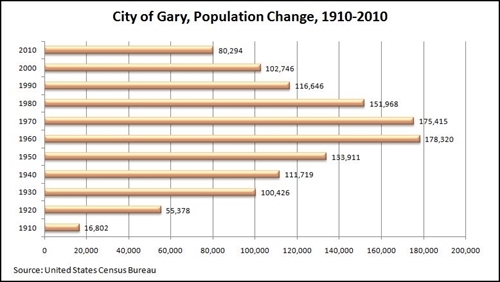
Map by Michael Piskur
Northwest Indiana's population change from 2000 to 2010
2010 Census data reveals dramatic shifts in Northwest Indiana and Northeastern Illinois’ population over the last decade. While much of the news coverage about the 2010 Census data has focused on the political ramifications of population changes, this new portrait of the region has a host of policy implications as well, from the need for workforce housing to impacts on traffic congestion. Over the next several weeks, MPC will offer snapshots of these regional shifts and analysis of how they will affect our work. Today’s post assesses how population changes in Northwest Indiana are informing regional redevelopment efforts.
MPC Research Assistant Michael Piskur contributed to this post.
Census snapshot
While total population numbers across Northwest Indiana’s Lake, La Porte, and Porter counties increased by nearly 4 percent between 2000 and 2010, the region’s most urban communities– East Chicago, Gary, Hammond, Michigan City, and Whiting – lost 12.7 percent of their residents during that same period. This change was most profound in Gary and East Chicago, which experienced respective losses of 21.9 percent and 8.4 percent.
While the number of minorities increased as a percentage of total population in all five urban core communities, minority gains did not make up for overall population declines. For example, while Hammond’s black population grew by more than 50 percent and its Latino population by 58 percent, overall population in Hammond still saw a net loss of 2.7 percent. Michigan City, despite a 78 percent increase in its Latino community, realized a population decline of 4.3 percent. Gary’s white, black, and Latino demographics all saw double-digit decreases. Overall, these five communities lost 18 percent of white residents and nine percent of black residents, while the Latino population grew by 22 percent.

Analysis
Although Northwest Indiana’s industrial cities began losing population long before 2000, the ongoing economic slowdown, spurred by the housing foreclosure crisis, has further propelled this trend. In the five urban core communities, vacant housing units increased by 46 percent; in fact, the numbers reveal nearly 16 percent of all existing housing units are now vacant. In Gary, vacant units increased by more than 51 percent and now comprise 20 percent of the city’s total housing stock, adding to the city’s blighted condition. Fortunately, Gary and neighboring cities are tapping federal resources to rehabilitate or remove many of the currently vacant and dilapidated structures.
Population loss means more than just growing numbers of vacant housing units: It’s contributing to the erosion of the municipal tax base in these communities, putting greater burden on fewer citizens to maintain local infrastructure and services, which meanwhile are serving fewer people. This added budgetary burden heightens the importance of funding made available through federal programs. Yet, there is also a chicken-and-egg problem: Funding through many federal programs is determined by a city’s population; a loss of people leads to a loss of federal funds.
Policy and planning responses
These trends underscore the importance of the Gary and Region Investment Project (GRIP), led by MPC and The Times Media Company; as well as Northwestern Indiana Regional Planning Commission’s (NIRPC) 2040 Comprehensive Regional Plan.
GRIP’s premise has been, “By working together as a region on key transformative investments, we can move Northwest Indiana forward.” The dual tenets of regional cooperation and targeted investment are critical to the success of the region.
Through an inventorying process, stakeholder interviews, and a public survey of some 800 people, GRIP is helping to identify these transformative investments that can stabilize the economy and spark investment in Gary and Northwest Indiana. Survey respondents indicated that residents prefer projects that will create jobs, spur economic development, and strengthen existing communities – all solutions to address economic contraction and population decline.
NIRPC’s 2040 Comprehensive Regional Plan for Northwest Indiana is the first of its kind in the region that marries transportation, economic development, environmental management, and land use. The plan is based on unprecedented public involvement, which shaped the regional 2040 Growth and Revitalization Vision adopted by the NIRPC board in October. This scenario, which forms the basis for the 2040 Plan, concentrates redevelopment and reinvestment in established communities that have lost population, including Gary and other urban core communities. It embraces constrained, planned growth, and encourages sustainable development within existing communities whose population centers will be more livable and vibrant. In fact, the goal of NIRPC’s 2040 Plan is for much of the expected growth—forecasted to be some 170,000 new residents by 2040—to occur within the urban core, helping to reverse decades of population losses and spur revitalization.
The 2040 Plan also addresses population growth that has occurred on the periphery of the traditional urban core, in communities such as Crown Point, St. John, and Winfield. By focusing on planned growth in “Livable Centers in Growth and Infill areas,” the 2040 Plan simultaneously values and protects the region’s natural, rural and agricultural assets.
So, while the new Census data reveals some alarming figures, it also supports Northwest Indiana’s status as a desirable place to live: Total population is growing in the region, and though not every community has the same industrial legacy, they all share the region’s key assets. Lake Michigan is the economic engine of Northwest Indiana, and provides drinking water to millions of people in the greater region. The lakefront offers exceptional economic development potential and will continue to attract people to adjacent communities. By working together and building on the region’s existing assets, the people of Northwest Indiana can create opportunities and improve quality of life for all residents.